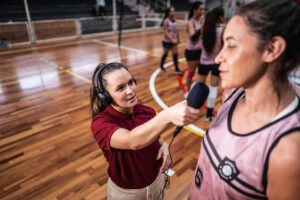Why a fair and just future requires ‘divestment’ from the status quo
One PR pro makes the case that organizations should interrogate all the places their budget is spent—and allocate resources to diverse vendors.

As I sit and watch our country contort and convulse in the wake of the death of George Floyd, I find myself being asked: “How are you doing?”
The question has sparked a debate and dialogue within myself, and I have been grappling with my own feelings and experiences.
The system that we have all invested in has come to an inflection point. The global pandemic (which still has no cure, lest we forget) has created a need for language that fully articulates what next could look and feel like— the “new normal,” a frighteningly accurate statement.
COVID-19 is, to my knowledge, the only globally and simultaneously shared experience in history. As a result, it has forced the majority of humanity to adjust their routine, reengage with boredom and self-reflection. Stories that may have historically flown under the radar are now spreading more virulently via social networks than the pandemic itself.
The “new normal” has allowed the world to realize that this system has us all under the proverbial knee, gasping for air. And that realization and shock is manifesting itself in the streets— locally and globally. This is why this moment feels different. This is why it looks different. And hopefully this time we will all contribute to making a difference.
So here we are. Less than a month after the death of Mr. Floyd, we see:
- All four officers involved in the murder of George Floyd have been charged with the murder of George Floyd, a rare occurrence. (See: Mapping Police Violence)
- The declaration #BlackLivesMatter coming from brands that were absolutely terrified of the phrase a few months ago.
- Widespread dialogue about race relations and systems of oppression in America. “How to be an Anti-Racist” is topping the charts. People are out buying books to learn about privilege.
- Protests taking place here across the U.S., in both “diverse” liberal cities and conservative small towns, and throughout Europe, Asia and Africa—sparking a dialogue in communities around the world about their own systems and dynamics.
- Conversation and debate about the role of police and how those funds should be reallocated to create safe environments for all.
- Juneteenth being recognized as a moment of national reflection & remembrance, and potentially enacted as a national holiday.
Ask ‘what’—not ‘how’
Back to the question: “How are you doing?” What if we transform it into a challenge, changing the “how” to “what”?
The “what” is what I mean by thinking about “divesting”—spurred by a series of questions:
- How much money have I “invested” into the existing system?
- How much personally?
- How much professionally?
- How much more would I invest assuming I maintain this level of success for another 10 or 20 years?
“What am I doing?” got me to think beyond donations. How could I create the “new normal” and become part of the change that I want to see? What actions of divestment can I take from the “existing system”? How can I start to divert funds into a rainbow coalition of creators, makers, farmers, laborers, storytellers, educators, technologists and more? Can it be done in a way that is immediate and scalable?
Doing the work
As a creative on the agency side I have heard lots of “discomfort” when this subject comes up—because you know, it seems too hard. I have seen various councils created to tackle the diversity problem, and their ultimate shelving as external pressures eased and conversations shifted, or as more immediate tasks with greater priority appeared. I have also seen the external and internal optics that result.
Externally, you create work that is a sea of sameness (see: Every Covid-19 Commercial is Exactly the Same). And here is why: When you tend to draw from the same talent pools that draw from the same colleges that tend to be filled with the same kinds of people it will naturally result in unremarkable output because the input—the creative perspectives—is the same, leaving your client to wonder why they are paying you all that money.
Internally, agencies become paralyzed, unable to actually address the subject let alone push clients to do better. For the “other” employees, they tend to feel tokenized and stunted professionally (see: ANA Diversity Report 2018) because the reality is that in today’s system, as you move up the chain, the likelihood of seeing someone that is above or beside you, who happens to look like you and reflect your experience, becomes less and less likely.
We all need to do better, including myself. As a creative, I have the power to shift the dialogue by creating stories that reflect the diversity of humanity, not only in front of the camera but also behind it. Here are some actions I’m taking to be better, and which I hope you’ll consider joining in, so that we all do better:
- On employment: Use the local community as a resource and build up a diverse talent pipeline by establishing relationships with local colleges and universities.
- On set & in production: Ask about diversity. No one is perfect. This is a process and will take effort. Assess where vendors are today and what steps are being taken to diversify the ranks. An easy first step is catering. Tap small businesses for food stuffs, that will at least divert some of the funds and impact the community.
- On the message: Present options that don’t reinforce stereotypes, avoid language that gives cover to ignorance and/or xenophobia (urban, mainstream, ghetto, bossy, flamboyant, exotic etc.) If your agency is not comfortable actively pushing back on (or walking away from) brands that tend to lean on stereotypes to deliver their marketing message and continue to distort the feed, don’t put an inappropriate option on the table.
It’s my belief that the majority of people in this world are kind, honest and good natured. Racism is a scourge that holds all of humanity backwards. I also believe that wallets are the most effective form of protest, the strongest accelerant for change. When we choose a monolithic chain (the irony is not lost here) over independent, boutique, minority-owned businesses or corporations that have committed to and are investing in a diverse workforce (from the boardroom to maintenance closet) we are aiding and abetting the system that we are calling out today.
I don’t pretend to have all the answers, but what is exciting about this new line of thinking and questioning is the vast array of opportunity that “the new normal” can bring. New perspectives, voices and talent will bring richer, more exciting experiences, innovations, and stories into the world.
If we take this moment to define and create #TheNewNormal, then we will all be able to focus on and contribute to solving outstanding issues like: climate change, energy resources, globalization, healthcare and the future of work, because some of us are not preoccupied with simply achieving the right to exist and to matter.
Sean DallasKidd is a partner & chief creative officer for Demonstrate.







Great article that makes me stop and ponder about what can I do as a PR professional to create a better “new normal”.